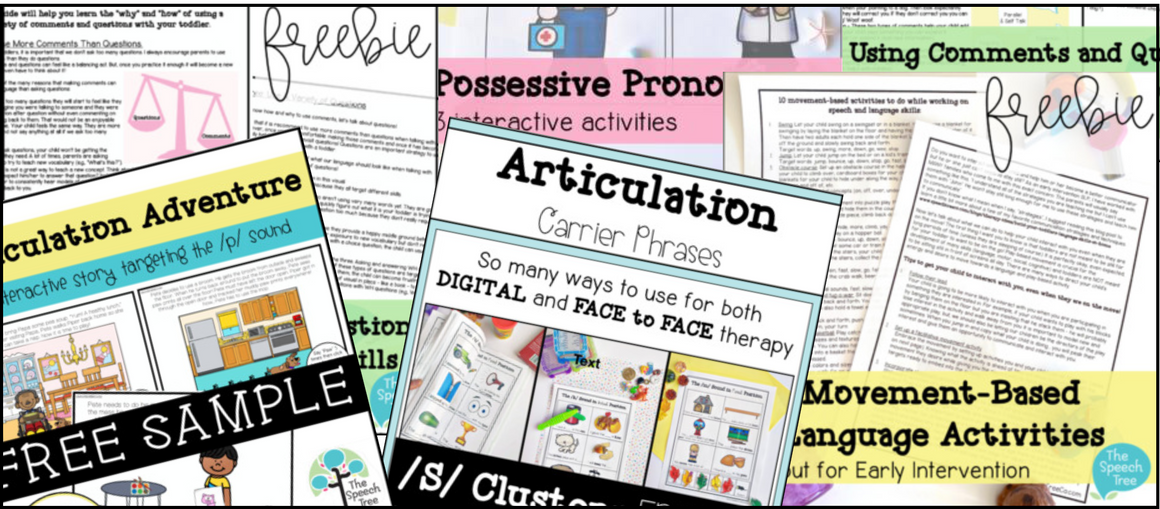How to Use Choices in Speech Therapy

Throughout our day, we, as adults, make so many choices (what to wear, what to eat, what time to leave the house). We are often so used to making all of these choices that we forget about how empowering it can feel to be in control of what happens in our lives!
Kids, especially little ones who don't dress or feed themselves yet, don't get to make very many choices for themselves throughout the day. Kids go from home (where someone is telling them what to do) to school (where someone is telling them what to do). It is no wonder that giving a child a simple choice can have such an effect on their behavior and actions.
Choices allow children to participate in the decision making process and have a role in the interaction. Choices can increase engagement (because they know they have a part in what is happening) and decrease unwanted behaviors (children will often "act out" if they become frustrated with everyone telling them everything they need to do all day long).
But, of course, it is not suggested to give children free reign of everything in their life. Instead, I suggest giving them controlled choices. Controlled choices means giving your child a limited set of choices, any of which you'd be okay with them choosing.
As a Speech-Language Pathologist, I incorporate controlled choices into every one of my sessions.
Here are some ways I use choices to increase engagement.
- Should we do this activity first or this activity first?
- What color highlighter should we use?
- Should we read this book or this book today?
I have seen giving choices be effective so much so that I created a resource around it! This resource for articulation was inspired by the increased engagement I saw when giving controlled choices.
Have you ever read the "Choose Your Own Adventure" books as a kid? They were so much fun! I used to read them for hours, turning back to the beginning over and over to see where every possible decision lead me.
I created a version of those types of books for articulation practice!
These books are digital and can provide anywhere from 50-100 trials and it is almost guaranteed that your students will be engaged. If that sounds interesting to you, you can check out the free sample book HERE or by clicking the pictures below. 

I also like to use choices in therapy when working with my Early Intervention clients (birth-3 years).
Giving controlled choices to a toddler can be extremely effective just like it can in older students. I see my toddler clients in the family's home so the choices I incorporate are usually to facilitate language during everyday routines.
These are some examples of controlled choices that I teach families to use to expand language and manage difficult behaviors during transitions throughout the day:
- Do you want mom or dad to read you a book?
- Do you want to brush your teeth or should I?
- Do you want to wear your brown or blue jacket?
- Should we put your shirt or your shoes on first?
- Do you want an apple or banana?
Giving choices can also be an excellent strategy to facilitate language growth from the late talker!
I love using choices with this age group for many reasons:
❓They can still answer by pointing or reaching, even if they don’t have verbal language yet.
❓They hear more vocabulary words throughout the day.
❓Yes/No questions do not give an opportunity for the child to use much language and WH questions may be too open-ended and difficult for the child to answer. Choice questions are a happy medium, allowing the child to point to or imitate the choice that they would like.
❓It allows them to have a role in the interaction. Parents are experts at knowing what their child needs and when they need it. Because of this, parents will often anticipate their child’s needs and just give the item to them rather than asking them what they want. Giving the child a choice (even if you already know what they want) will give them a turn in the interaction and an opportunity to build their language skills.
❓In fact, starting with something that you know they want is a good idea. You can set your child up for success by modeling the correct option second. For example, you know they want crackers so you would say crackers second (Do you want apples or crackers). When starting out with choices, children will often just imitate the second option. As they begin to become more familiar with choices and their vocabulary grows you can start to switch up the order. Always give them the one they asked for to help them understand the effect their words and gestures have on other people.
❓Choices can help with behaviors related to transitions and lack of control. By giving your child a choice, you are letting them have some control over what they eat/drink/do which can help reduce negative behaviors.
Leave a comment
Comments will be approved before showing up.




